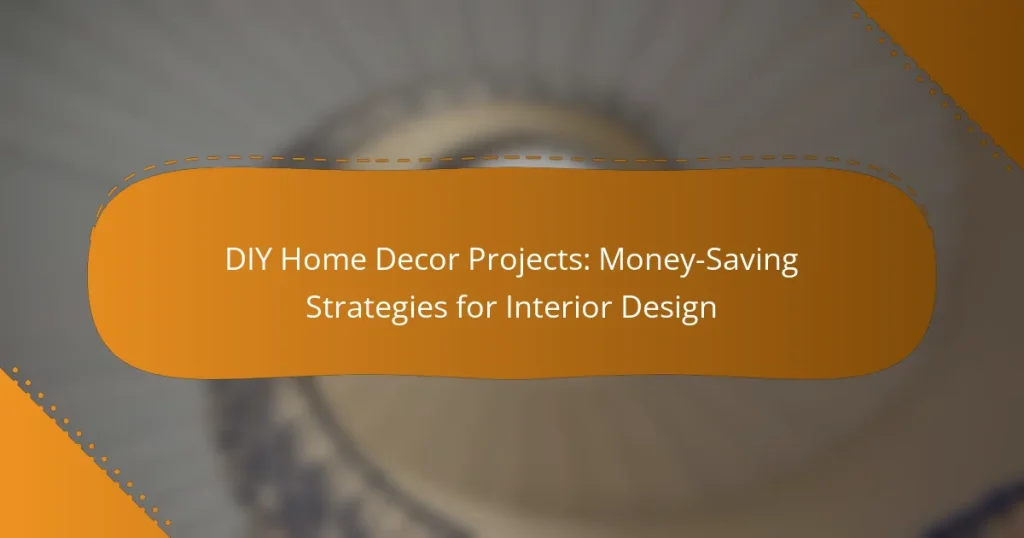DIY home decor projects offer an excellent way to personalize your space while saving money. By tapping into your creativity and using readily available materials, you can craft unique items that reflect your style without the hefty price tag of store-bought decor. With careful planning and consideration of your skills and budget, you can embark on projects that are both enjoyable and rewarding.

How can DIY home decor projects save money?
DIY home decor projects can significantly reduce costs by allowing you to create personalized items without the high price tag of store-bought alternatives. By using your creativity and resourcefulness, you can transform your space while keeping expenses low.
Cost-effective materials
Choosing cost-effective materials is crucial for saving money on DIY projects. Look for alternatives like reclaimed wood, which can often be found for free or at a low cost, and upcycled fabrics that can add character without breaking the bank. Local hardware stores may offer discounts on surplus or damaged items that can be creatively repurposed.
Consider using paint or stain to refresh old furniture instead of buying new pieces. A gallon of paint can cost around $30 to $50 and can cover multiple projects, making it a budget-friendly option for a fresh look.
Budget-friendly tools
Investing in a few essential tools can save you money in the long run. Basic tools like a drill, saw, and measuring tape are often sufficient for a variety of projects. Many local community centers or tool libraries offer rental services, allowing you to borrow tools instead of purchasing them outright.
When buying tools, look for sales or second-hand options. Websites like Craigslist or Facebook Marketplace often have listings for gently used tools at a fraction of the retail price, helping you stay within budget.
Repurposing existing items
Repurposing existing items is an effective way to save money while reducing waste. Before discarding old furniture or decor, consider how you can give them new life. For example, an old ladder can be transformed into a unique bookshelf, and glass jars can serve as stylish storage containers.
Take inventory of what you already have and brainstorm creative uses. This approach not only saves money but also adds a personal touch to your home. Remember to share your ideas with friends or family; they might have items they no longer need that you can use in your projects.

What are popular DIY home decor projects?
Popular DIY home decor projects include creative and cost-effective ways to enhance your living space. These projects often utilize readily available materials and can be tailored to fit various styles and budgets.
Pallet wood furniture
Pallet wood furniture is a trendy and sustainable option for DIY enthusiasts. By repurposing wooden pallets, you can create items like coffee tables, benches, or shelving units at a fraction of the cost of store-bought furniture.
To get started, gather clean pallets, which can often be found for free or at a low cost. Sand them down to remove splinters, and consider applying a wood stain or paint for a polished finish. Ensure the pallets are safe for indoor use, as some may have been treated with chemicals.
Fabric wall art
Fabric wall art is an easy and affordable way to add color and texture to your walls. This project involves using fabric remnants or old clothing to create unique pieces that reflect your personal style.
To make fabric wall art, stretch the fabric over a canvas or frame and secure it at the back. You can mix and match patterns for a collage effect or use a single bold print for a statement piece. This project allows for creativity while keeping costs low, as you can often use materials you already have at home.
Upcycled planters
Upcycled planters transform everyday items into beautiful homes for your plants. This project not only saves money but also reduces waste by giving new life to old containers.
Common items to upcycle include tin cans, glass jars, and wooden crates. Ensure that any container you choose has proper drainage holes to prevent overwatering. Decorate the planters with paint or twine to enhance their aesthetic appeal while showcasing your plants in style.

How to choose the right DIY decor project?
Choosing the right DIY decor project involves evaluating your skills, determining the scope of the project, and setting a realistic budget. By carefully considering these factors, you can select a project that is both enjoyable and feasible, ensuring a successful outcome.
Assessing skill level
Your skill level is crucial in selecting a DIY decor project. Consider what you are comfortable with—whether it’s painting, woodworking, or sewing. If you’re a beginner, start with simpler projects like creating wall art or upcycling furniture, which require minimal tools and techniques.
For those with more experience, consider intermediate projects such as building shelves or crafting custom light fixtures. Always be honest about your abilities to avoid frustration and ensure a satisfying result.
Determining project scope
Defining the scope of your DIY decor project helps you manage your time and resources effectively. Start by identifying the area you want to decorate, such as a living room or bedroom, and the specific changes you wish to make—like adding shelves or repainting walls.
Break down the project into manageable steps, and consider how much time you can realistically dedicate each week. This approach prevents overwhelm and allows you to enjoy the creative process.
Setting a budget
Establishing a budget is essential for any DIY decor project. Determine how much you are willing to spend on materials, tools, and any additional costs like paint or fabric. A practical range for small projects might be between $50 to $200, while larger undertakings could require several hundred dollars.
To save money, consider using reclaimed materials or shopping at discount stores. Always keep a small buffer in your budget for unexpected expenses, ensuring you can complete your project without financial strain.

What tools are essential for DIY home decor?
Essential tools for DIY home decor include a mix of hand tools and power tools that enable you to create and modify furniture and decor items effectively. Investing in a good set of tools can save you money and time while enhancing your creative projects.
Basic hand tools
Basic hand tools are crucial for any DIY home decor project. Essential items include a hammer, screwdrivers, pliers, a tape measure, and a utility knife. These tools allow you to perform a variety of tasks, from assembling furniture to making precise cuts.
When selecting hand tools, prioritize quality over quantity. A few reliable tools can serve you well for multiple projects. For example, a good-quality tape measure can help ensure accurate measurements, reducing the likelihood of costly mistakes.
Power tools for advanced projects
Power tools can significantly enhance your DIY capabilities, especially for more complex projects. Common power tools include drills, saws, and sanders. These tools can help you cut materials more efficiently and achieve professional-looking finishes.
Consider investing in a cordless drill and a circular saw for versatility. A cordless drill is useful for both drilling holes and driving screws, while a circular saw can handle larger cuts with ease. Always read the manufacturer’s instructions to ensure safe and effective use.
Safety equipment
Safety equipment is vital for protecting yourself while working on DIY home decor projects. Essential items include safety goggles, gloves, and a dust mask. These tools help prevent injuries from flying debris, sharp edges, and harmful dust particles.
Always wear safety goggles when using power tools and gloves when handling rough materials. A dust mask is particularly important when sanding or cutting wood to avoid inhaling harmful particles. Investing in safety equipment is a small price to pay for your well-being during projects.

Where to find inspiration for DIY home decor?
Finding inspiration for DIY home decor can be an exciting journey. Numerous resources are available, ranging from online platforms to local community events, which can spark creativity and provide practical ideas for your projects.
Home improvement blogs
Home improvement blogs are a fantastic source of inspiration for DIY decor. They often feature step-by-step guides, project ideas, and tips from experienced DIYers. Popular blogs may cover a range of styles, from modern minimalism to rustic charm, helping you discover what resonates with your taste.
Look for blogs that include before-and-after photos, as these can provide a clear vision of what’s possible. Many bloggers also share budget-friendly solutions, making it easier to implement your ideas without overspending.
Social media platforms
Social media platforms like Pinterest and Instagram are treasure troves for DIY home decor inspiration. On Pinterest, you can create boards to save your favorite ideas and explore themes that match your style. Instagram allows you to follow influencers and hashtags related to home decor, providing a constant stream of fresh ideas.
Engage with the community by commenting on posts or sharing your projects. This interaction can lead to valuable feedback and tips from others who share your passion for DIY decor.
DIY workshops in local communities
Participating in DIY workshops within your local community can be a great way to gain hands-on experience and inspiration. Many home improvement stores and community centers offer classes where you can learn new skills, such as painting techniques or furniture upcycling.
These workshops often provide materials and tools, allowing you to experiment without a significant upfront investment. Additionally, connecting with fellow DIY enthusiasts can lead to new ideas and collaborations for future projects.

What are the benefits of DIY home decor?
DIY home decor offers numerous advantages, including cost savings and the ability to create a space that truly reflects your personal style. By taking on projects yourself, you can customize your environment while often spending significantly less than hiring a professional.
Personalized design
One of the primary benefits of DIY home decor is the opportunity for personalized design. You can tailor every aspect of your project to match your unique tastes and preferences, ensuring that your home feels distinctly yours. This level of customization is often difficult to achieve with store-bought items.
When planning a DIY project, consider your color palette, materials, and overall theme. For example, if you love rustic aesthetics, you might choose reclaimed wood for shelves or upcycle vintage furniture. This not only enhances your space but also adds character and a story to your decor.
To maximize personalization, gather inspiration from various sources such as Pinterest or design blogs. Create a mood board to visualize your ideas and help guide your project. Remember to keep your budget in mind; sourcing materials from local thrift stores or online marketplaces can lead to unique finds at a fraction of retail prices.


